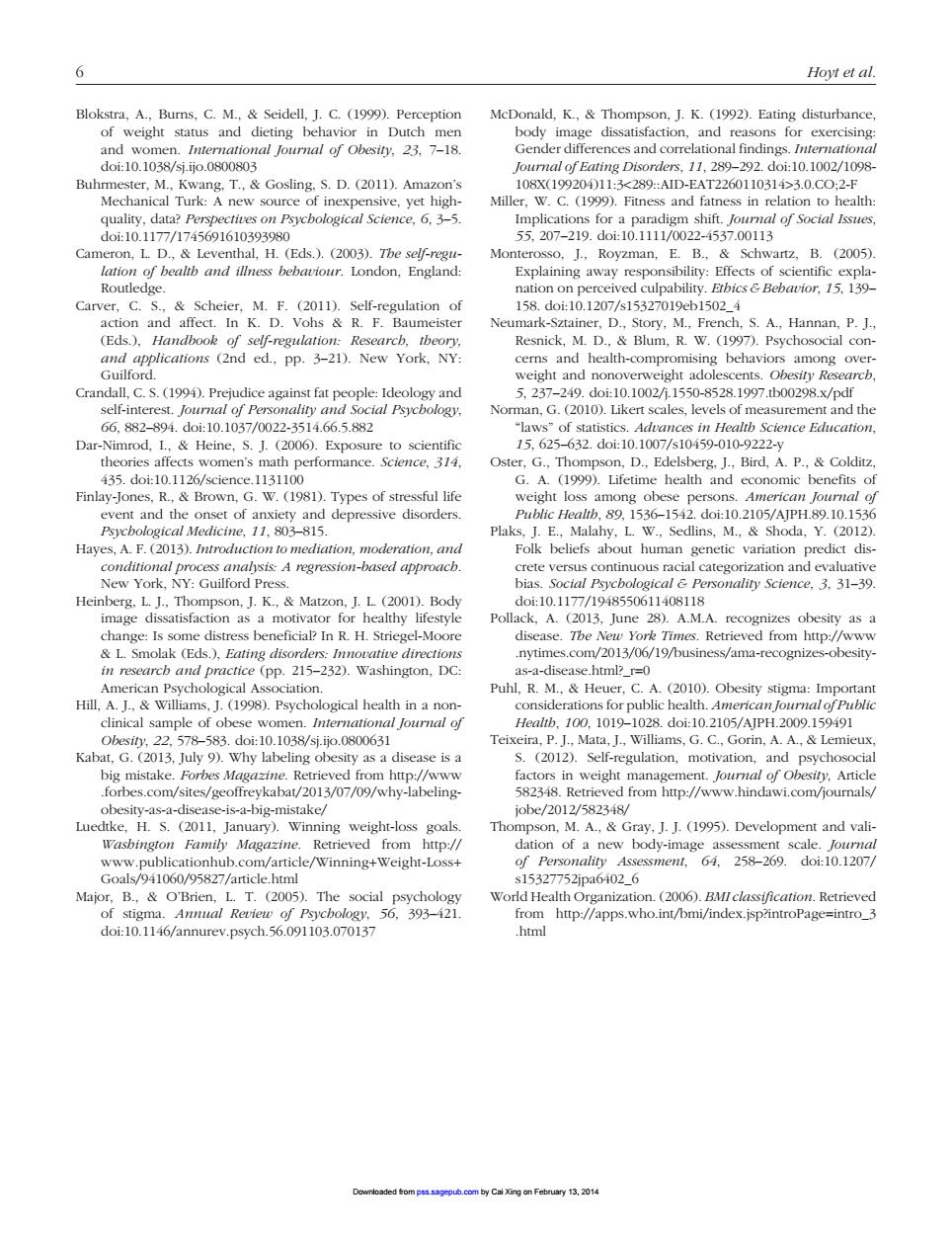正在加载图片...

Hoyt et al. Gosling.S.D.(2011).Amazon's Mechanical Turk:A new source of yet high Cameron,1. (Eds.).(2003).The sefregu Monterosso,J.,Royzman,E.B..Schwartz,B.(2005) ealtb and ebaviour.London.England Ne cems and heath-compromising ove Crandall,C..(1).Prejudi e against fat people:Ideology and Dar-Nimrod,I. Heine,S.J.(2006).Exposure to scientifi 22 Finlay-Jones,R..&Brown.G.W.(1981).Types of stressful life Plaks.E.Malahy.L Sedlins.M.shoda,Y.C2012) Folk beliefs about human genetic variation predict dis New York.NY:Guilford Press bias.Social Psycbological sclence. Heir Body Pollack:A (2013.lune 28)A MA disease.The N Puhl,R.M.Heu bat.G.(2013.July 9)why labeling opesiry &Lemieux ved from h factors in weight manag forbe.com/e//07/why-labeling 82348Re from hutp://www.hindawi.com/ouml Luedike.H.S.(2011.January).Winning weight-loss Thompson,M.&Gray,(15).Development and vai of a new ofBiy Ass smenl..258-269.doi:102m The social World Health ication.Retr html 6 Hoyt et al. Blokstra, A., Burns, C. M., & Seidell, J. C. (1999). Perception of weight status and dieting behavior in Dutch men and women. International Journal of Obesity, 23, 7–18. doi:10.1038/sj.ijo.0800803 Buhrmester, M., Kwang, T., & Gosling, S. D. (2011). Amazon’s Mechanical Turk: A new source of inexpensive, yet highquality, data? Perspectives on Psychological Science, 6, 3–5. doi:10.1177/1745691610393980 Cameron, L. D., & Leventhal, H. (Eds.). (2003). The self-regulation of health and illness behaviour. London, England: Routledge. Carver, C. S., & Scheier, M. F. (2011). Self-regulation of action and affect. In K. D. Vohs & R. F. Baumeister (Eds.), Handbook of self-regulation: Research, theory, and applications (2nd ed., pp. 3–21). New York, NY: Guilford. Crandall, C. S. (1994). Prejudice against fat people: Ideology and self-interest. Journal of Personality and Social Psychology, 66, 882–894. doi:10.1037/0022-3514.66.5.882 Dar-Nimrod, I., & Heine, S. J. (2006). Exposure to scientific theories affects women’s math performance. Science, 314, 435. doi:10.1126/science.1131100 Finlay-Jones, R., & Brown, G. W. (1981). Types of stressful life event and the onset of anxiety and depressive disorders. Psychological Medicine, 11, 803–815. Hayes, A. F. (2013). Introduction to mediation, moderation, and conditional process analysis: A regression-based approach. New York, NY: Guilford Press. Heinberg, L. J., Thompson, J. K., & Matzon, J. L. (2001). Body image dissatisfaction as a motivator for healthy lifestyle change: Is some distress beneficial? In R. H. Striegel-Moore & L. Smolak (Eds.), Eating disorders: Innovative directions in research and practice (pp. 215–232). Washington, DC: American Psychological Association. Hill, A. J., & Williams, J. (1998). Psychological health in a nonclinical sample of obese women. International Journal of Obesity, 22, 578–583. doi:10.1038/sj.ijo.0800631 Kabat, G. (2013, July 9). Why labeling obesity as a disease is a big mistake. Forbes Magazine. Retrieved from http://www .forbes.com/sites/geoffreykabat/2013/07/09/why-labelingobesity-as-a-disease-is-a-big-mistake/ Luedtke, H. S. (2011, January). Winning weight-loss goals. Washington Family Magazine. Retrieved from http:// www.publicationhub.com/article/Winning+Weight-Loss+ Goals/941060/95827/article.html Major, B., & O’Brien, L. T. (2005). The social psychology of stigma. Annual Review of Psychology, 56, 393–421. doi:10.1146/annurev.psych.56.091103.070137 McDonald, K., & Thompson, J. K. (1992). Eating disturbance, body image dissatisfaction, and reasons for exercising: Gender differences and correlational findings. International Journal of Eating Disorders, 11, 289–292. doi:10.1002/1098- 108X(199204)11:3<289::AID-EAT2260110314>3.0.CO;2-F Miller, W. C. (1999). Fitness and fatness in relation to health: Implications for a paradigm shift. Journal of Social Issues, 55, 207–219. doi:10.1111/0022-4537.00113 Monterosso, J., Royzman, E. B., & Schwartz, B. (2005). Explaining away responsibility: Effects of scientific explanation on perceived culpability. Ethics & Behavior, 15, 139– 158. doi:10.1207/s15327019eb1502_4 Neumark-Sztainer, D., Story, M., French, S. A., Hannan, P. J., Resnick, M. D., & Blum, R. W. (1997). Psychosocial concerns and health-compromising behaviors among overweight and nonoverweight adolescents. Obesity Research, 5, 237–249. doi:10.1002/j.1550-8528.1997.tb00298.x/pdf Norman, G. (2010). Likert scales, levels of measurement and the “laws” of statistics. Advances in Health Science Education, 15, 625–632. doi:10.1007/s10459-010-9222-y Oster, G., Thompson, D., Edelsberg, J., Bird, A. P., & Colditz, G. A. (1999). Lifetime health and economic benefits of weight loss among obese persons. American Journal of Public Health, 89, 1536–1542. doi:10.2105/AJPH.89.10.1536 Plaks, J. E., Malahy, L. W., Sedlins, M., & Shoda, Y. (2012). Folk beliefs about human genetic variation predict discrete versus continuous racial categorization and evaluative bias. Social Psychological & Personality Science, 3, 31–39. doi:10.1177/1948550611408118 Pollack, A. (2013, June 28). A.M.A. recognizes obesity as a disease. The New York Times. Retrieved from http://www .nytimes.com/2013/06/19/business/ama-recognizes-obesityas-a-disease.html?_r=0 Puhl, R. M., & Heuer, C. A. (2010). Obesity stigma: Important considerations for public health. American Journal of Public Health, 100, 1019–1028. doi:10.2105/AJPH.2009.159491 Teixeira, P. J., Mata, J., Williams, G. C., Gorin, A. A., & Lemieux, S. (2012). Self-regulation, motivation, and psychosocial factors in weight management. Journal of Obesity, Article 582348. Retrieved from http://www.hindawi.com/journals/ jobe/2012/582348/ Thompson, M. A., & Gray, J. J. (1995). Development and validation of a new body-image assessment scale. Journal of Personality Assessment, 64, 258–269. doi:10.1207/ s15327752jpa6402_6 World Health Organization. (2006). BMI classification. Retrieved from http://apps.who.int/bmi/index.jsp?introPage=intro_3 .html Downloaded from pss.sagepub.com by Cai Xing on February 13, 2014